
Sir William Hamo Thornycroft was an English sculptor, responsible for some of London's best-known statues, including the statue of Oliver Cromwell outside the Palace of Westminster. He was a keen student of classical sculpture and was one of the youngest artists to be elected to the Royal Academy, in 1882, the same year the bronze cast of Teucer was purchased for the British nation under the auspices of the Chantrey Bequest.

Smethwick is an industrial town in Sandwell, West Midlands, England. It lies 4 miles (6 km) west of Birmingham city centre. Historically it was in Staffordshire and then Worcestershire before being placed into then West Midlands county.
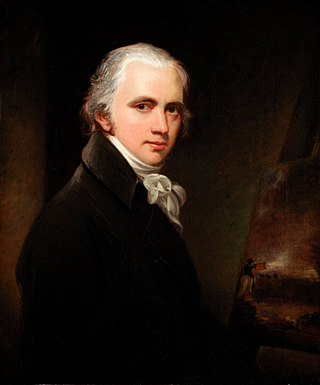
Sir William Beechey was a British portraitist during the golden age of British painting.

Sir William Rothenstein was an English painter, printmaker, draughtsman, lecturer, and writer on art. Though he covered many subjects – ranging from landscapes in France to representations of Jewish synagogues in London – he is perhaps best known for his work as a war artist in both world wars, his portraits, and his popular memoirs, written in the 1930s. More than two hundred of Rothenstein's portraits of famous people can be found in the National Portrait Gallery collection. The Tate Gallery also holds a large collection of his paintings, prints and drawings. Rothenstein served as Principal at the Royal College of Art from 1920 to 1935. He was knighted in 1931 for his services to art. In March 2015 'From Bradford to Benares: the Art of Sir William Rothenstein', the first major exhibition of Rothenstein's work for over forty years, opened at Bradford's Cartwright Hall Gallery, touring to the Ben Uri in London later that year.

Sir John Lavery was an Irish painter best known for his portraits and wartime depictions.
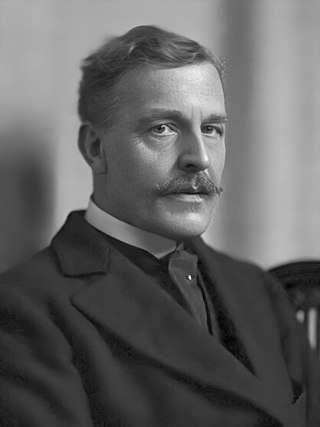
Sir James Guthrie was a Scottish painter, associated with the Glasgow Boys. He is best known in his own lifetime for his portraiture, although today more generally regarded as a painter of Scottish Realism.

Sir George Reid PRSA was a Scottish artist.
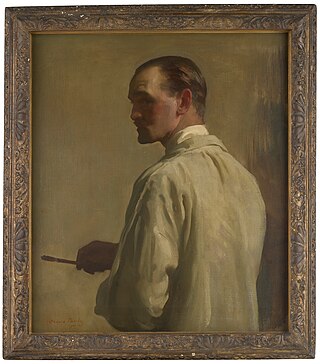
Sir Oswald Hornby Joseph Birley was an English portrait painter and royal portraitist in the early part of the 20th century.

John Henry Lorimer was a Scottish painter who worked on portraits and genre scenes of everyday life.
Julian Opie is a visual artist of the New British Sculpture movement.

Chance Brothers and Company was a glassworks originally based in Spon Lane, Smethwick, West Midlands, in England. It was a leading glass manufacturer and a pioneer of British glassmaking technology.

The Chance Baronetcy, of Grand Avenue in the parish of Hove in the County of Sussex, is a title in the Baronetage of the United Kingdom. It was created on 19 June 1900 for James Timmins Chance, a grandson of William Chance, one of the Chance brothers who started the family business in 1771. He became head of Chance Brothers and Company. He was High Sheriff of Staffordshire in 1868.
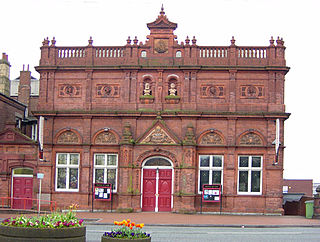
Wednesbury Museum and Art Gallery is a purpose-built Victorian art gallery in Wednesbury in the West Midlands of England. It is notable for its Ruskin Pottery collection and for hosting the first public display of the Stuckism art movement.

Beatrice Offor (1864–1920) was a British painter. She is primarily known for portraits, often of an esoteric nature.
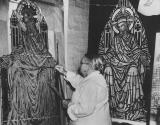
Florence Camm was a British stained-glass artist, painter and metalworker associated with the Arts and Crafts movement. Camm and her brothers, Walter and Robert, took over the management of the family stained-glass business after her father, T. W. Camm died in 1912. Camm was the principal designer of the firm until her death in 1960.

Orleans House was a Palladian villa built by the architect John James in 1710 near the Thames at Twickenham, England, for the politician and diplomat James Johnston. It was subsequently named after the Duc d'Orléans who stayed there in the early 19th century. By the early 20th century it was derelict and in 1926 it was mostly demolished. However, parts of the property, including a baroque octagonal room designed by architect James Gibbs, were preserved. The octagon room and its service wing are listed Grade I by Historic England and, together, with a converted stable block, are now the Orleans House Gallery, a gallery of art relating to the London Borough of Richmond upon Thames and neighbouring areas of London.

Francis John Williamson was a British portrait sculptor, reputed to have been Queen Victoria's favourite.

West Smethwick Park is a public park in the St Pauls ward of Smethwick, England. It opened on 7 September 1895 on land donated by James Timmings Chance.

Sir James Timmins Chance, 1st Baronet was an English industrialist, philanthropist, director of the London and North Western Railway, and an expert in lighthouse optics. He served in public office, including as a Justice of the Peace for Staffordshire and Worcestershire in 1851, Deputy Lieutenant of Staffordshire in 1856 and for Worcestershire in 1859, and High Sheriff of Staffordshire in 1868.


















